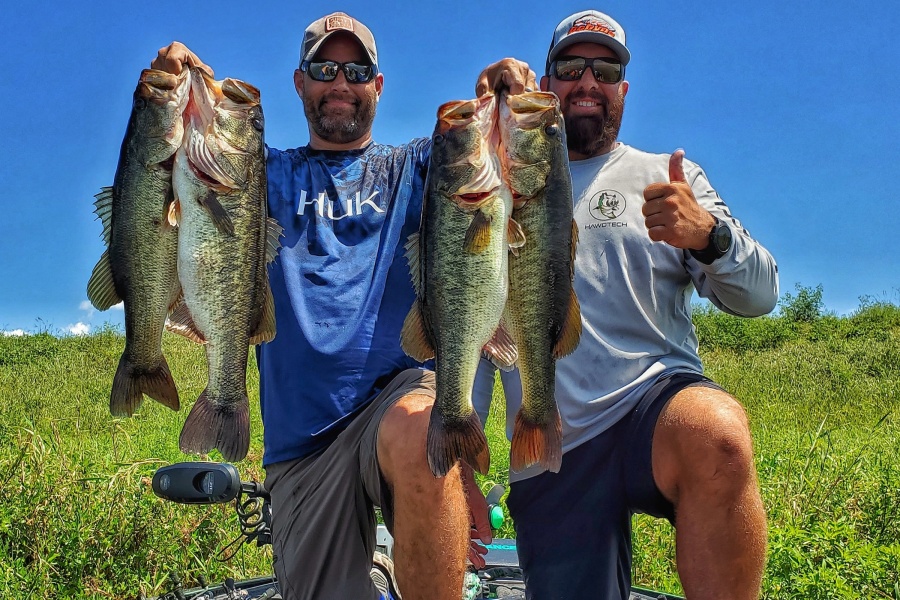As autumn arrives, it's time to master fall bass fishing. Cooling water sparks hungry aggression in bass seeking to fatten up for winter. Read on to discover prime locations to find active bass, effective lure choices, and key seasonal tips to adapt your strategies for fall fishing success.

Fall Bass Fishing Strategies
Fall Bass Behavior
In the world of bass fishing, success often hinges on understanding the intricate dance of nature. As we delve into the heart of fall bass fishing strategies, we will start by looking at the behavior of these autumn bass.
Impact of Temperature Change
The drop in temperature tells bass that the long, cold winter is only a few months away. This means they have to start bulking up because it is very hard to find food during cold months.
Now that the temperatures are not super high, bass don’t have to worry about overheating, so they can expend lots of energy chasing after and hunting down prey. Bottom line, fall bass are hungry and aggressive.
Main Forage
Baitfish will be the main forage of autumn bass. Amphibians and insects have mostly gone away or died out by this point. Bass will also eat lots of crawfish during these months, but crawfish spend most of their time stuck to the bottom or under rocks, so it is easier for bass to target bluegill, shad, baby bass, and other smaller fish.
Where to Find Bass in the Fall
Shallow Water
The cooler temperature allows bass to move up into shallow water. They also use this as a hunting strategy by trapping prey between them and the bank. This leaves the prey with no escape. Bluegill are the main target prey for shallow water bass.
Moving Water
Moving water contains lots of oxygen which gives fish an extra boost in energy. Bass will wait in this water for prey to flow right into them. Not all bodies of water have moving water such as small lakes and ponds. But if your lake does, make sure to take full advantage of it.
Open Water
All summer, bass hold to cover to get away from the hot sun. But during the fall the temperatures are cool enough for bass to cruise more open waters in search of food. These bass are always very aggressive and typically easy to catch.
Best Lures for Fall Bass Fishing
Since fall bass are very active and aggressive, it is best to use lures that cover lots of water and make lots of vibration and sound.
- Crankbaits: Effective for mimicking injured baitfish and covering large areas of water.
- Spinnerbaits: Ideal for drawing reaction strikes and imitating schooling baitfish.
- Jerkbaits: Excellent for mimicking wounded prey and enticing sluggish bass.
- Topwater lures: Great for surface action, especially during early morning and late evening.
- Swimbaits: Realistic baitfish imitations that work well in various conditions.
- Lipless crankbaits: Effective for fishing over submerged vegetation or along drop-offs.
Fall Stages and Tips
Navigating the shifting seasons is a crucial aspect of fall bass fishing success. Here are some valuable tips to help you adapt to the changing conditions and optimize your fishing strategy throughout the autumn months:
Identifying Early Fall Conditions:
- Monitor water temperature closely; when it begins to drop from summer hot weather highs, early fall patterns emerge.
- Look for signs of baitfish activity, as bass will follow their prey.
- Focus on shallower waters initially, as bass often move closer to shore in early fall.
Mid-Fall Strategies:
- As temperatures continue to drop, bass move deeper and become more focused on feeding.
- Target structure like points, humps, and drop-offs where bass congregate.
- Experiment with various lures to match changing forage preferences.
Late Fall Adjustments:
- As winter approaches, bass slow down and become less active.
- Shift to slower presentations and finesse techniques.
- Consider downsizing your lures and fishing deeper waters, especially near wintering holes.
Stay Flexible:
- Continuously adapt your approach based on current conditions, weather, and bass behavior.
- Be patient and willing to change locations and techniques if you're not getting bites.
- Keep a keen eye on water clarity, as it can change rapidly during the fall season.
Timing Matters:
- Plan your fishing trips around peak feeding times, often during dawn and dusk.
- Be aware that weather changes, such as approaching cold fronts, can influence bass activity.
When Does the Fall Fishing Season End?
Reeling this In










